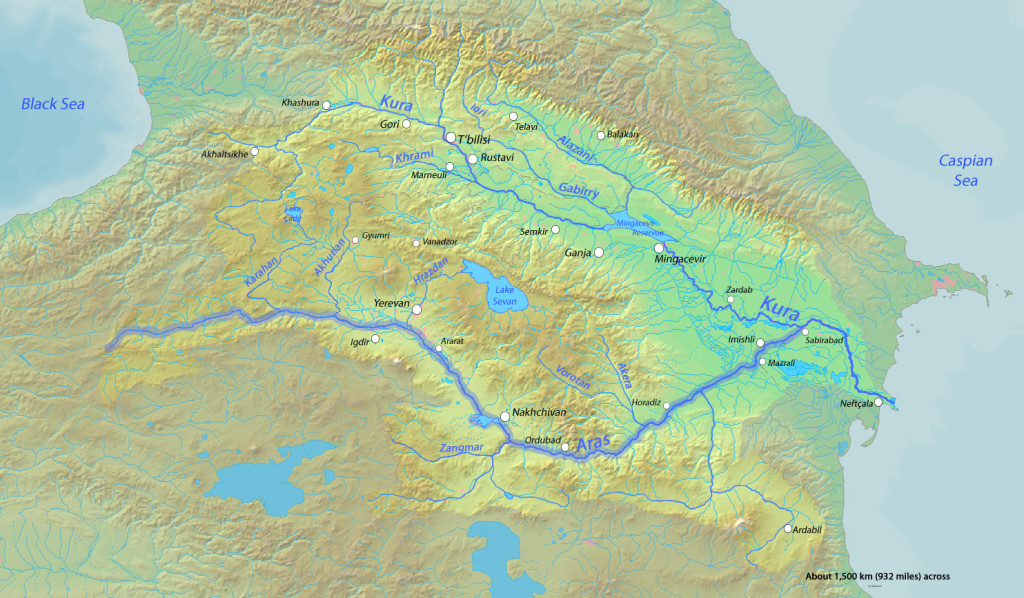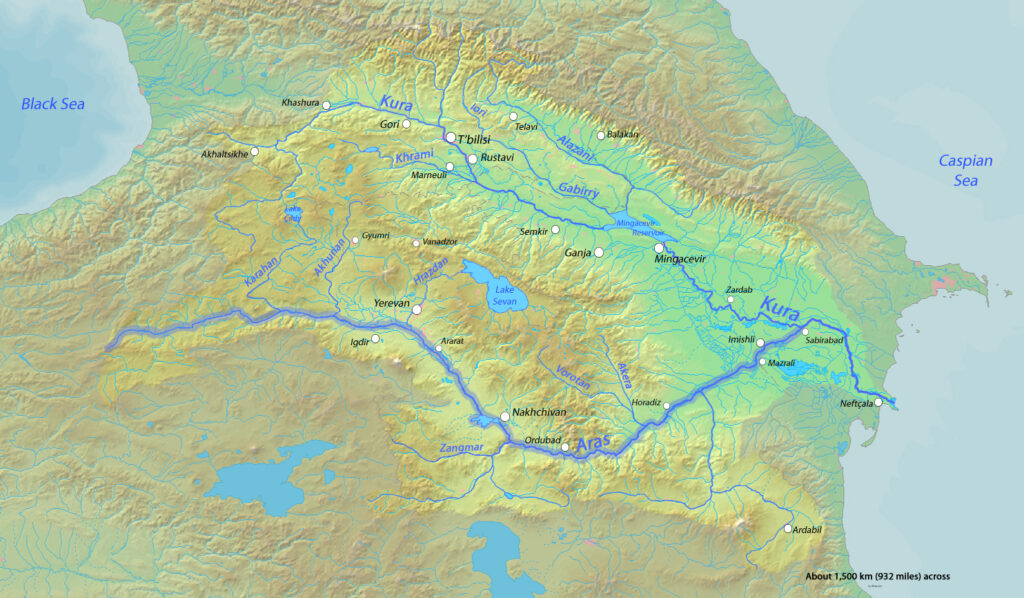
International borders are designed to control the people, goods and even the information moving across them. Among these resources, water stands as one of the most critical, and least cooperative. In the Caucasus region, transboundary water resources shared by Armenia and Azerbaijan in the Kura-Araks river basin force these two fierce adversaries into limited cooperation. Georgia, the third stakeholder in the river basin, often acts as an informal mediator in negotiations between its estranged neighbors. In the past, some observers saw these negotiations as a formula for long-term resolution of the frozen conflict in Nagorno-Karabakh (a large territory in southwestern Azerbaijan), where ethnic Armenians continue to assert their independence from Azerbaijan. However, growing water scarcity in the Caucasus and climate change in the larger region could poison this water partnership and ignite a second, even more catastrophic Nagorno-Karabakh War between the neighboring countries.
Water access in the Caucasus has been an issue of concern since the early 20th century, when population growth and Soviet industrialization made water scarce. Both Armenia and Azerbaijan get the vast majority of their surface water resources from the Araks (also spelled Aras, Araz and Arax) and Kura (Kur) rivers originating in the eastern highlands of Turkey. Georgia also depends on this river basin for agricultural and municipal use; its capital, Tbilisi, was built along the shores of the Kura. When Armenia, Azerbaijan and Georgia were part of the Soviet Union, all of this water was governed by Moscow, which made bilateral treaties with Turkey and Iran to ensure equal access to Kura-Araks water for all countries in the region.
When the USSR collapsed, however, the capital and technology-intensive water infrastructure built by the Soviets in these countries fell into disrepair, causing several minor water crises and forcing farmers and herders to sell their land and migrate elsewhere. Likewise, the Soviet framework for water sharing between Azerbaijan, Armenia and Georgia also fell apart. To make matters worse, the breakup of the Soviet Union corresponded with a brutal war between Armenia and Azerbaijan in the early 1990s, when ethnic Armenian separatists in the Nagorno-Karabakh region attempted to break away from Azerbaijan and unite with Armenia. Large-scale hostilities died down in 1994, with small skirmishes along the border between Azerbaijan, Armenia and the de facto-independent Nagorno-Karabakh Republic every year since. As a result of this perpetual low-intensity conflict, Armenia and Azerbaijan have no diplomatic ties and their populations regard each other as mortal enemies. The political friction is immense, stalling even the most basic level of cooperation.
Azerbaijan, the downstream state in the basin, is the worst off in the stalemate. Unlike Armenia and Georgia, it lacks access to sustainable groundwater resources and experiences periodic upstream river flooding that damages agricultural land. Above all, Azerbaijan suffers from upstream pollution of the Kura-Araks basin. Both Georgia and Armenia dump huge volumes of pollutants including industrial chemicals and heavy metals into the rivers with little water monitoring or treatment. As a result, Azerbaijan struggles to find adequate water supplies that aren’t already polluted. In Baku, the capital city of more than 2 million people, only a fraction of municipal water is safe to drink and available throughout the day. While Baku lies outside the river basin itself, even the communities located deep within the river basin struggle to get potable, clean water.
Meanwhile Armenia faces its own dilemma. The country is sandwiched between Turkey and Azerbaijan, allied countries that both resent Armenia’s existence and have long since closed their borders to it. The resulting economic isolation makes Armenia energy-poor, vulnerable to frequent electrical outages and dependent on primitive fuel sources like timber and coal. Armenia uses so much local timber for heating that it now faces large-scale deforestation, which in turn leads to shrinking water tables and further erosion in the river basin. Armenia’s isolation from its immediate neighbors is the major reason behind the country’s close relationship with its Collective Security Treaty Organization and Eurasian Economic Union (EEU) partner, Russia. As things stand, Russia provides Armenia with energy and security guarantees, while Armenia gives Russia a strategic foothold in the Caucasus and added political legitimacy for bodies like the EEU. If not for the Russian military base in Gyumri, Armenia’s second largest city, Azerbaijan may have already invaded. Armenia has enough water to meet its needs at present, but like its neighbors, it lies in a region identified as “high stress” for water scarcity. Armenia also has problems with water pollution; according to Azerbaijan, water flowing downstream from Armenia appears to be virtually untreated, containing raw sewage, chemicals and pharmaceutical products.
Georgia rounds out the Caucasus water troika. As an ancient wine-producing nation and a net food exporter, Georgia depends on the Kura River, glacial runoff from the Caucasus Mountains, rainfall and underground aquifers for agricultural irrigation. Because of this diversity of sources, Georgia is not water-poor or water-insecure like Azerbaijan or Armenia. However, its territory covers a large part of the Kura River basin and its economic activity contributes heavily to the degradation of the waters running downstream to Azerbaijan. Its own municipal water supply is also seriously contaminated. Key pollutants include manure, fertilizer, industrial chemicals and sewage from major urban areas like Tbilisi. Georgia also gets more than 60% of its electricity from hydroelectric dams, which lessen water quantity and quality within the larger river basin.
Georgia’s relatively good relations with its two neighbors have made it an important intermediary for key transboundary issues. In 2002, the governments and civil society actors of Georgia, Azerbaijan and Armenia met in Tbilisi for a water management summit, drafting several key resolutions on how to improve water management in the region. These included expanding water monitoring activities on both sides of the border, easing data exchange and cooperation among scientists and regulatory authorities, developing a joint industrial water pollution mitigation strategy and continuing the dialogue on sustainable water use in the river basin. The European Commission then gave these resolutions legs with several phases of multimillion-euro grants. In November 2015, Azerbaijan and Georgia reached a new bilateral agreement on transboundary water from the Kura River. Georgia has also signaled that it will ratify the Water Convention, which would introduce stricter standards for pollution control and monitoring in its waterways.
In spite of this progress, the fundamental problem of water pollution and scarcity in the Caucasus remains. None of the stakeholders in the region are doing enough to truly address these issues with long-term solutions. Data sharing and water monitoring between Azerbaijan and Armenia is still woefully lacking, and without this key information, policymakers cannot begin to address water sharing and pollution reduction (even if they were willing to cooperate). Population growth and climate change will only exacerbate the situation.
There are many other factors contributing to instability in this region: Azerbaijan is currently dealing with widespread protests and civil disturbances linked to soaring food prices and high unemployment. These events are echoes of the demonstrations against political corruption and electricity shortages in Armenia in 2015. In Georgia, memories of the 2008 Russian invasion and de facto annexation of Abkhazia and South Ossetia remind the populace that good fences do not always make good neighbors.
Most importantly, the threat of another war over Nagorno-Karabakh looms over everything. In the near future, water could easily become the underlying factor that re-ignites the conflict. Azerbaijan’s military spending has long-since dwarfed Armenia’s. Its increasing capabilities and boldness have manifested in dozens of skirmishes along its border with Armenian-controlled territory over the last year. Fatalities on both sides have reached historically high levels since the 1994 cease-fire.
If Azerbaijan’s current economic woes continue, one severe drought could lead to riots in the streets of Baku. Similar events took place in Syria before its civil war: ongoing drought devastated the agricultural economy, causing massive rural-to-urban migration by unemployed farmers and herdsmen. These people formed the bulk of the anti-government protesters who toppled the political order in 2011, sparking war and insurgency. If Azerbaijani president Ilham Aliyev feels enough social pressure, he could choose to go to war with Armenia to distract and unify the population. This act would risk Russian intervention, but given Russia’s weak economy and its entanglement in eastern Ukraine and Syria, now could be an opportune moment for Azerbaijan to strike.
This extreme scenario is just one potential outcome of a prolonged water crisis. But the real likelihood of violence and hardship in the Caucasus due to future water scarcity should motivate the international community to tackle this problem. As mentioned before, the EU Commission has already helped fund several key projects involving shared water monitoring and related tasks. The United States has a strategic interest in preserving Caucasus stability and fostering peace, and could make a large impact with ongoing USAID grants similar to those of the EU Commission, which encourage institutional-level cooperation between Armenian and Azerbaijani monitoring agencies. In addition to monitoring and data collection, larger projects involving the improvement of existing water utilities and the construction of new infrastructure would also make a significant improvement in water scarcity. The objective should be to foster cooperation and interdependence between the quarreling neighbors. When it comes to water, Azerbaijan and Armenia must work together, or suffer together.
The views expressed by the author do not necessarily reflect those of the Glimpse from the Globe staff, editors or governors.
AUTHOR BIO: Jaim Coddington studied international relations and Russian language at American University in Washington, DC. He is a former Symington and Critical Language Scholar, and he is currently working as a 2nd Lieutenant in the Marine Corps.







